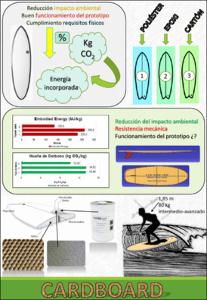Mostra el registre d'ítem simple
Diseño y fabricación de una tabla de surf
| dc.contributor | Sanz Collado, Gerard |
| dc.contributor.author | Ruíz Martínez, José Carlos |
| dc.contributor.other | Universitat Politècnica de Catalunya. Departament d'Expressió Gràfica a l'Enginyeria |
| dc.date.accessioned | 2019-01-04T12:27:25Z |
| dc.date.available | 2019-01-04T12:27:25Z |
| dc.date.issued | 2018-07-11 |
| dc.identifier.uri | http://hdl.handle.net/2117/126165 |
| dc.description.abstract | [CASTELLÀ] El objetivo de este proyecto es la fabricación de un prototipo de una tabla de surf, con el cual se busca dar solución a los principales problemas medioambientales, de contaminación, resistencia mecánica, etc. que presentan los materiales más utilizados en la actualidad. Para ello se realiza un estudio del proceso de producción y de las propiedades y características de los materiales utilizados actualmente en la industria del surf. Se busca un diseño polivalente para utilizar en diferentes tipos de olas, siendo su usuario un varón de 80 kg, 1,8m y un nivel intermedio-avanzado. Inicialmente se realiza un estudio de la anatomía y las formas de una tabla de surf; para posteriormente diseñar un prototipo para sacar el máximo rendimiento surfeando, proporcionando un buen desarrollo en el agua. Una vez conocidas las exigencias mecánicas necesarias para el funcionamiento de una tabla de surf se proponen una serie de materiales y se realiza un estudio de los posibles sustitutos de los actuales, anteponiendo los más sostenibles (madera, cartón “nido de abeja”, fibra de carbono, fibras naturales, resinas naturales y resinas ecológicas). Teniendo en cuenta todas las características mecánicas, las propiedades medioambientales y los factores económicos; los materiales escogidos son el cartón “nido de abeja”, la fibra de vidrio y la resina de poliéster. Conocida la cantidad de cada material y sus propiedades medioambientales se puede asegurar un claro descenso de la huella de carbono (emisión de kg de CO2 durante el ciclo de vida) y la de la energía incorporada (energía (MJ) por kilogramos (kg) de producto desde su extracción hasta el final de su vida útil). Finalmente se estudian los tipos de procesos de fabricación de tablas de surf que existen en la actualidad para proceder a la fabricación del prototipo. Como resultado del proceso de fabricación, el cartón “nido de abeja” presenta problemas a la hora de proporcionar la rigidez necesaria y dificulta que la fibra de vidrio junto a la resina se impregne en él. Llegado a este punto se presentan diferentes soluciones a los dos problemas presentados, mantenido los materiales escogidos y buscando en todo momento una reducción del impacto ambiental. |
| dc.description.abstract | [ANGLÈS] This project aims to create a prototype model of a surfboard. It intends to provide a solution for the main problems (i.e., environmental concerns, pollution, mechanical strengths, etc.) arising from the application of specific materials which are most commonly used nowadays. For this purpose, research is conducted on the current production processes found in the industry of surf, including the properties and characteristics of the materials which are most widely used. The goal is to create a multi-purpose design, to be used on different wave types and by an 80-kilogram, 1.8-meter male, having an intermediate-advanced level in surf practice. Firstly, a study is made about the design and form of a surfboard, so as to outline then a prototype with the most efficient results when surfing, and delivering a good performance on water. Once we know about the most basic mechanic requirements for a correct performance of a surfboard, a range of different materials are put forward and analysed with a view to substitute the current, ordinary components. This is done by prioritizing the more sustainable materials, such us wood, honeycomb-structured cardboard, natural fibre and natural and ecological resins. Considering all the mechanic implications, the environmental characteristics and economic factors, the chosen materials are the honeycomb cardboard, fiberglass and polyester resin. After analyzing the amount of each material and their environmental properties, we can guarantee a significant reduction in carbon footprint (amount of carbon dioxide released during its life cycle) and embodied energy [energy (MJ) per kilograms (kg) of the product from extraction to the end of its life cycle.] Finally, we have a look at the manufacturing processes of a surfboard and proceed to the production of a prototype. As a result of the manufacturing process, the honey-comb cardboard causes some difficulties in terms of rigidity and the fiberglass with the resin permeates the cardboard hardly. At this point, different solutions to these two problems are proposed, while keeping the chosen materials and aiming to reduce its environmental impact. |
| dc.language.iso | spa |
| dc.publisher | Universitat Politècnica de Catalunya |
| dc.rights | Attribution-NonCommercial-NoDerivs 3.0 Spain |
| dc.rights.uri | http://creativecommons.org/licenses/by-nc-nd/3.0/es/ |
| dc.subject | Àrees temàtiques de la UPC::Arquitectura::Disseny::Disseny industrial |
| dc.subject.lcsh | Surfboards -- Design and construction |
| dc.subject.lcsh | Sustainable design |
| dc.subject.other | Cartón “nido de abeja” |
| dc.subject.other | Sostenible |
| dc.subject.other | Diseño |
| dc.subject.other | Medioambiente |
| dc.subject.other | Prototipo |
| dc.subject.other | Tabla de surf |
| dc.subject.other | Resina de Poliéster |
| dc.subject.other | Fabricación |
| dc.subject.other | Fibra de vidrio |
| dc.subject.other | Honeycomb cardboard |
| dc.subject.other | Sustainable design |
| dc.subject.other | Prototype |
| dc.subject.other | Surfboard |
| dc.subject.other | Polyester resin |
| dc.subject.other | Manufacturing |
| dc.subject.other | Fiberglass |
| dc.title | Diseño y fabricación de una tabla de surf |
| dc.type | Bachelor thesis |
| dc.subject.lemac | Disseny sostenible |
| dc.subject.lemac | Surf -- Aparells i accessoris |
| dc.rights.access | Open Access |
| dc.audience.educationlevel | Grau |
| dc.audience.mediator | Escola Politècnica Superior d'Enginyeria de Vilanova i la Geltrú |
| dc.audience.degree | GRAU EN ENGINYERIA MECÀNICA (Pla 2009) |






